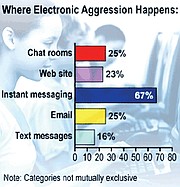Cyberbullying: A pervasive issue leading to higher rates of depression
Sexual harassment is a term most adults are familiar with in the professional world — the concept of children imposing or being victims of sexual harassment may seem uncommon.
Harassment, sometimes beginning as early as elementary school, has transformed through the years and is labeled various ways.
Cyberbullying, bullying, hazing and sexual harassment have been added to the list of terms used to define the behaviors some students encounter.
The first known use of cyberbullying was in 2000, by definition the word means: the electronic posting of mean-spirited messages about a person (as a student) often done anonymously.
However, mean-spirited messages are only one of the ways teens are harming one another.
Electronic messaging through e-mail, text, forums, blogs and social-networking sites are some of the tools used to harass.
Cyberbullying has been described as a passive-aggressive form of bullying — an attacker does not have to identify themselves.
A scandalous picture can be sent instantly to anyone, destroying the reputation of another student.
Pictures can be copied from Internet sites and labeled with a victim’s name, leading recipients of the picture to believe the information provided by the sender.
A study conducted during the school year of 2010-’11 surveyed middle-and high-school students about harassment and bullying; the study revealed 48 percent of students surveyed were sexually harassed at least once at school by peers.
According to a recent report by the American Association of University Women (AAUW), female students are more likely to experience harassment, and 56 percent of girls reported harassment compared to 40 percent of male students.
Social-networking Websites like Facebook, Formspring and Twitter provide an open forum for people to post comments to approved “friends” accounts.
All other users will see, depending on the privacy settings to the user’s account, whatever comment is posted to an individual’s account.
The Facebook terms-of-use requires account users to be at least 13 years old.
However, the process of setting up an account only requires a birth date and year — making it easy for kids to enter a year of their choice, thus making them as old as they want to appear online.
Websites like Facebook can circulate information quickly, rumors and stories can be posted in a matter of minutes. According to the AAUW, 44 percent of students said they were harassed face-to-face, while 30 percent of students said there were cyberbullied.
Cyberbullying has been found to cause higher depression rates when compared to other forms of bullying. The inability for a victim to identify their attacker is said to be dehumanizing. Cyberbullying laws were established in 2005 to protect victims from this electronic form of gang violence.
Local interviews with students, parents and school faculty in Libby and Troy revealed various perspectives. A cross-section of students was interviewed at elementary-middle-and high-school levels. Some of the students interviewed claimed to be bullies, some victims, and included females, males and/or athletes.
Interestingly, several students declined their interviews because of fear — fear their attackers would discover they “talked.”
• Every student interviewed admitted the inappropriate and mean comments frequently posted on social-networking sites;
• Regardless if the acts of cyberbullying or harassment took place at school or after school, students admitted it was difficult to return to school;
• Several of the students were victims of scandalous pictures text to a mass group of people,
• Students admitted feeling uncomfortable discussing cyberbullying with a teacher or counselor — saying they felt more comfortable telling a friend.
Local school faculty, when asked to comment on the subject of cyberbullying and sexual harassment in school, were reluctant to talk and be identified in this article. Confidentiality is crucial between students and school counselors. To respect the privacy of students and maintain a level of loyalty, counselors were reluctant in a small community to share specifics that might pinpoint certain victims.
“If you go to a counselor to talk about sexual harassment or bullying you’ll be ‘labeled,’ a 17-year old local student said. “It’s better to just tell your friends and not report it to the school.”
According to a recent survey, 4-out-of-5 parents believe their child is in a “safe and secure” environment at school. The survey did not indicate the opinions of students, although a portion of school faculty, willing to provide an opinion, believe most students would say they feel safe.
Strict policies have been established in schools to address the issues of bullying, hazing, cyberbullying and sexual harassment in schools. Principals, counselors and teachers admitted they are aware of the issues impacting students today, and the schools have worked to create a no-tolerance policy for bullying and harassment.
However, schools are limited to what they know — if kids do not report bullying and/or harassment the school cannot help to rectify the situation. Incidents involving bullying and harassment may result in the suspension of the attacker, and if the issue goes unresolved, the student may face expulsion.
For more information about cyberbullying, laws and social-networking sites visit http://parentesource.com/category/social_networking/
https://doj.mt.gov/safeinyourspace/for-teens-tweens-cyberbullying/





